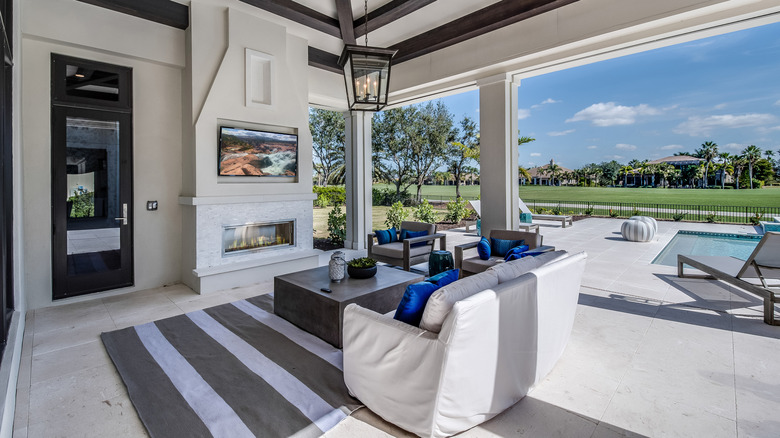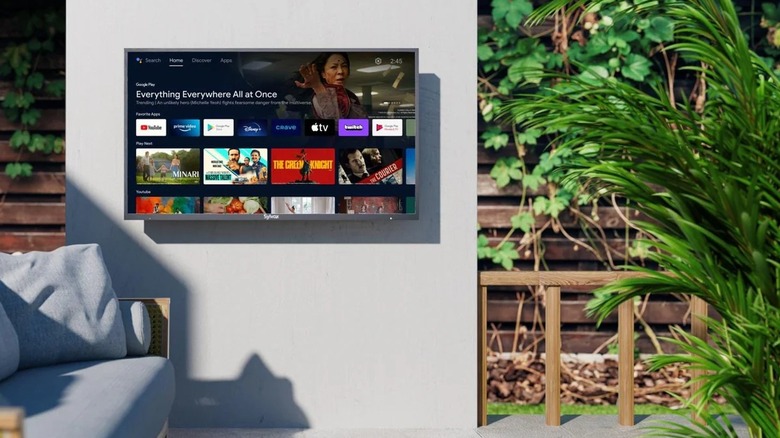Can You Put A Regular TV Outside? (And What Temperatures Can It Withstand?)
Those with access to a nice outdoor area, like a covered patio, might consider moving their flatscreen TV out into the fresh air. After all, on a comfortable day, wouldn't it be nice to enjoy sports or even a movie out on your deck? It sounds like a great time, but it's not advisable to mount your living room TV outside.
However, if you're determined to use your indoor TV outdoors, there are steps you can take to help protect it, albeit at the risk of voiding your warranty. You can purchase a special weatherproof enclosure that helps reduce the impact of nature. However, a proper case that shields the unit from rain, snow, and blown debris isn't cheap, and depending on your screen size, it could be anywhere from a few hundred to over $1000. In addition, you'll want to keep it as dry as possible from humidity, by perhaps placing some of those desiccant silica gel packets, which absorb moisture into the enclosure. However, the elements will take a toll on your set, and you could be significantly shortening operating life, no matter what preventative measures are taken.
It's important to note the distinction between a regular TV's operating temperatures and storage temperatures. For example, Insignia stipulates on its 39-inch LED (NS-39D310NA19) that when in use, the unit can tolerate between 41 and 104 degrees Fahrenheit. However, when turned off and in storage, the same TV can endure environments from 32 up to 122 degrees Fahrenheit.
There are TVs made specifically for the outdoors
Rather than risk the health of your regular TV, you could opt for a dedicated outdoor unit specially designed with the elements in mind. Take, for example, the Sylvox Pool Pro Outdoor TV we reviewed and put to the test in snowy mid-west conditions. These unique TVs can operate well outside the constraints of a regular television. For example, the 55-inch Samsung Terra QLED Outdoor TV can run in temperatures from as low as -22- up to 122 degrees Fahrenheit.
Another measure of these outdoor TVs' resistance to the elements is the IP (Ingress Protection) rating some of them offer. Models like the Samsung Terra boast their enclosure rates an IP55. The first number indicates on a scale of 0 to 6 (6 being the most resistant) how protected the TV is from dust. The second number describes how safe the TV is from multidirectional pressurized water and runs from 0 to 9.
Unfortunately, one of the biggest reasons some people choose to risk mounting their indoor TV outdoors is that outdoor sets are a massive financial hit to the wallet. In fact, models like C SEED'S N1 outdoor TV look incredible, but cost as much as a house. For those wishing to take their entertainment beyond the confines of the home, here is why outdoor TVs are so expensive and whether they are worth it.
Consider your regions weather and outdoor setup
Regardless of your location, a mild and comfortable day would likely be ideal for enjoying television outdoors. But, how often does your area get pleasant weather, and how much of the year would you be better off inside? For example, certain places in the US, like San Diego, feature a narrower temperature fluctuation with colder months rarely dipping below 50 degrees Fahrenheit, and summer heat usually staying below 80 degrees Fahrenheit. However, other cities aren't so fortunate, like Phoenix, Arizona, which saw triple-digit temperatures for 113 consecutive days in 2024, according to KJZZ.org. Conversely, states like North Dakota have an average temperature of 39.9 degrees Fahrenheit, which can drop to between 2 and 17 degrees Fahrenheit in the winter.
In addition to how often you'll be able to comfortably take advantage of a television outdoors, you'll need to be aware of other external factors. For example, will the TV be near a backyard pool? This places the sensitive electronics at elevated risks of moisture damage due to splashing, unless protected by an enclosure. Will the TV be installed in an area that provides some shade or in direct sunlight? Many manufacturers like LG warn against placing TVs in direct sunlight, and even specialized outdoor-designed sets are placed into categories like partial sun and full sun models.


